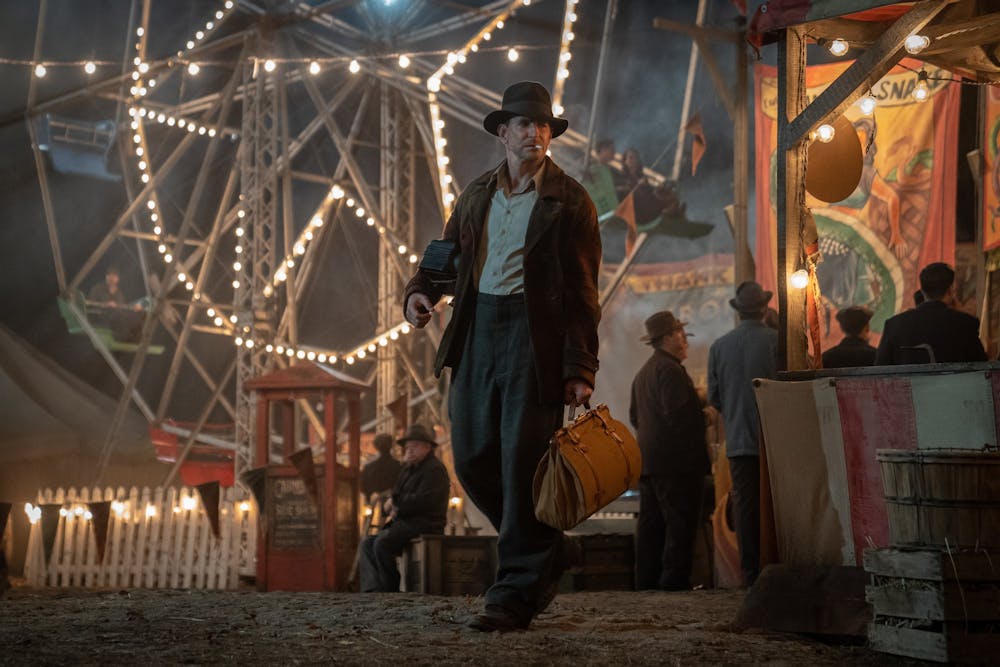“People fool themselves.” It is this chilling truth that overshadows the fatalistic trajectories of fallible characters in Guillermo del Toro’s Oscar-nominated melodrama, “Nightmare Alley,” a remake of the classic 1947 noir based on William Lindsay Gresham’s novel of the same name.
Bradley Cooper plays the main character, Stanton Carlisle, a man haunted by a past as dark and despicable as the film’s traveling carnivals, in which both humans and animals are abused and exploited to the delight of carnival audiences. It is then no surprise that this is also where Stan chooses to lay low for the time being at the start of the film.
Still, it may only be through the glimpses of violence shown early on that audiences are made dimly aware of Stan’s calculating ruthlessness. To the tawdry crew of carnival performers, hired and overseen by the more brazenly cold-blooded Clem (Willem Dafoe), Stan is charming and personable. He changes his demeanor effortlessly to match the seedy environment, utilizing the hospitality of married mind-reading duo Zeena (Toni Collette) and Pete (David Strathairn).
Joining the couple for homely meals and banter, Stan is quickly drawn to their mentalism act, a masterfully crafted performance that once launched the husband and wife on tours across Europe. Pete eventually reveals, on one dreary night, the secret behind the pair’s bygone success — divination tricks actually relying on secret verbal codes and hand gestures between the assistant and psychic.
Pete also teaches Stan the nuances of mentalism and clairvoyance. People too often think themselves difficult to read. Yet people’s eagerness to be read, somewhat similar to a reader’s willing suspension of disbelief while perusing a novel, is palpable once the act is underway. All one needs to do is to be attentive to the details that belie one’s identity, the breadcrumbs of the past littered across one’s appearance, ranging from an uneven gait to jewelry, clothing and other trinkets.
Stan’s fascination with the craft of mind-reading brings to the forefront the film’s central question of seeing and being seen. Del Toro’s darkly sumptuous scenes, more often practical set pieces than computer-generated ones, are meticulously speckled with the motif of a watchful eye. As Stan takes on the persona of a burdened mentalist after leaving the carnival, his confidence in his skill and wit turns into self-destructive hubris.
Standing center-stage in high-end nightclubs and wearing a silk bandana — featuring an image of the single premonitory eye — that ironically obscures his vision, Stan seems to read the unseen. In time, this supposed omniscience feeds into his desires for more fame, more profits. It becomes all too clear that Stan is blind to the fact that he is being watched, read and dissected.
With the entrance of Cate Blanchett’s Dr. Lilith Ritter, an amoral psychiatrist with a network of influential clientele, Stan’s life gradually spins out of control. “You don’t fool people, Stan,” Lilith hisses into his ear, “they fool themselves.” Caught carrying out a grifting act with everything to lose, he fails spectacularly. The psychic thus betrays his own prideful folly, catalyzed by lust and an insatiable greed. The film ends with a brilliantly cynical and cyclical note, ultimately returning Stan to his starting point as a penniless nobody, desperate to hunker down as a dilapidated carnie along the train tracks.
As a crime thriller, “Nightmare Alley” burns slowly. Reminiscent of del Toro’s other recent films such as 2017’s “The Shape of Water,” there is a sense of impending doom. Characters are so obsessively bent on abstract desires and ambitions that they lose their moral compass and a grounded sense of self, careening toward a disaster audiences await with bated breath. It is mesmerizing to watch, especially in a del Toro film, which unerringly fascinates through dedicated world-building dashed with the ethereal element of a dark fairy tale.
Nonetheless, the choice to extend the film’s runtime half an hour longer than the original remains dubious. There is more storytelling, making it a more comprehensive adaptation of the novel. But characters beside Stan lack authenticity as individuals, especially Lilith. Blanchett's stellar performance may initially dazzle and captivate, but, stretched over some 40 minutes, audiences may start to wonder as to why she is the way she is. The unknown of her past shows a missed opportunity to clarify the motives behind her interactions with Stan. A truly compelling villainess requires a shrouded backstory with a little more flesh on its bones. Otherwise, her wanton destruction becomes arbitrary.





